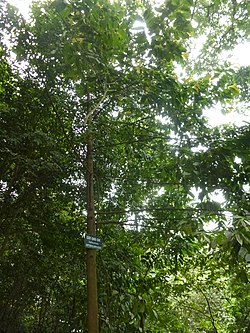| Parashorea chinensis | |
|---|---|
 | |
| Scientific classification | |
| Kingdom: | Plantae |
| Clade: | Tracheophytes |
| Clade: | Angiosperms |
| Clade: | Eudicots |
| Clade: | Rosids |
| Order: | Malvales |
| Family: | Dipterocarpaceae |
| Genus: | Parashorea |
| Species: | P. chinensis |
| Binomial name | |
| Parashorea chinensis Wang Hsie (1977) | |
| Synonyms [2] | |
| |

Parashorea chinensis is a large species of tree (40–72 m tall) in the family Dipterocarpaceae. It is native to southern China (Yunnan and Guangxi provinces) and in northern Laos and Vietnam. It is threatened by habitat loss. [1] The species is under first-class national protection in China. [3]
The tallest reliably measured individual published in journals is a 72.4 m approximately 150 year-old tree found in a Karst sinkhole within the seasonal tropical rainforest of Nonggang National Natural Reserve in Chongzuo, Guangxi province. [4]
